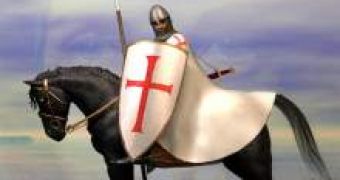The answer to the question of "Who were the Knights Templar" is likely to generate a variety of opinions, depending on who answers the question. Christians, crusaders, anti-Christian demon worshipers or the first and greatest of the monastic warriors who fought during the Crusades are but a few of the many theories related to the Templars.
After the victory of the First Crusade a group of knights, led by Hugues de Payens, offered themselves to the Patriarch of Jerusalem as a military force. The military force had intended to protect the Christian pilgrims who were en route to the Holy Land. In the year 1118 AD King Baldwin II granted the Templars quarters on the Temple Mount. Coincidence or not for nine years the order consisted of only nine knights. In the year 1127 the Cistercian abbot, Bernard of Clairvaux, wrote a rule of order for the Templars that was based on his own Cistercian order's rule of conduct. Additionally, Hugues de Payens journeyed to the West to seek the approbation of the Church and to obtain recruits. They accepted not only the three perpetual vows, besides the crusader's vow, but also the austere rules concerning the chapel, the refectory, and the dormitory. They also adopted the white habit of the Cistercians, adding to it a red cross. While it is true that the Templars were not permitted, by their rule, to own much of anything personally, there was no such restriction on the order as a whole. As such the gifts of land were accepted and put to immediate use by the order. In the process, the order became wealthy. Aside from the gifts they were receiving, the Templars were experts in commerce and free from the taxation imposed on other orders.
In addition to their estates, the Knights Templar were also rich in relics. Relics were the remains of people or things which had featured in the New Testament stories. A popular relic at the time was a piece of Wood from the True Cross - the cross on which Jesus had been crucified. Another was the Head of John the Baptist, who was beheaded after Herod was bewitched by the seductive dance of Salome. People in the Middle Ages were desperate for relics, which they venerated with awe. But as you might expect, there were plenty of frauds around. Several heads of John the Baptist were in circulation. And there were enough splinters of wood from the 'true cross' to make up any number of crucifixes! The Templars had in their possession the Crown of Thorns, taken from the head of Christ. They also had the body of the martyred Saint Euphemia of Chalcedon (thought to have divine healing powers). They had a cross made from a bath supposedly used by Jesus, a bronze cross made out of the bowl Jesus had used to wash his disciples' feet at the Last Supper, and a sizeable collection of other relics besides.
However, in less than two centuries, the Templars would meet their demise perhaps because of their wealth or fear of their seemingly limitless powers. It is generally known that Philip IV was envious of the Templars' wealth and sought to secure it for himself. Regardless of the motivation, the order was taken down at the hands of the Pope and the King of France in 1307. In 1307 Philip had the Templars arrested on grounds of heresy; since this was the only charge that would allow the seizing of their money and assets. The Templars were tortured and confessions were given. These confessions included: trampling and spitting on the cross, homosexuality and sodomy, and even worshipping of an idol named Baphomet.
"Public indignation was aroused by ... charges of ... worshipping the devil in the form of an idol called Baphomet." Baphomet was "the Templar symbol of Gnostic rites based on phallic worship and the power of directed will. The androgynous figure with a goat's beard and cloven hooves is linked to the horned god of antiquity, the goat of Mendes." ( Peter Tompkins, The Magic of Obelisks.)
Another theory suggests that Baphomet is a compound of the words 'baphe' (baptism) and 'metis' (wisdom). Both theories imply the Templars were worshipping, or at least privy to, a secret knowledge. Several commentators believed this points to the Templars having been gnostics (a philosophical doctrine characterized by the incorporation of the Hellenistic philosophy into the Christian theology).
Philip was successful in ridding the Templars of their power and wealth and urged all fellow Christian leaders to do the same thing. Seven years later, in 1314, the last Grand Master of the Knights Templar, Jacques de Molay, was burned at the stake. De Molay is said to have cursed King Philip and Pope Clement as he burned, asking both men to join him in death within a year. Whether the story is an apocryphal legend or a matter of historical fact depends largely on one's point of view. Anyway, Pope Clement V died only one month later and Philip IV seven months after that.
A contemporary had described the Templars as "in turn lions of war and lambs at the hearth; rough knights on the battlefield, pious monks in the chapel; formidable to the enemies of Christ, gentleness itself towards His friends." (Jacques de Vitry). ... and SO they were ...

 14 DAY TRIAL //
14 DAY TRIAL //